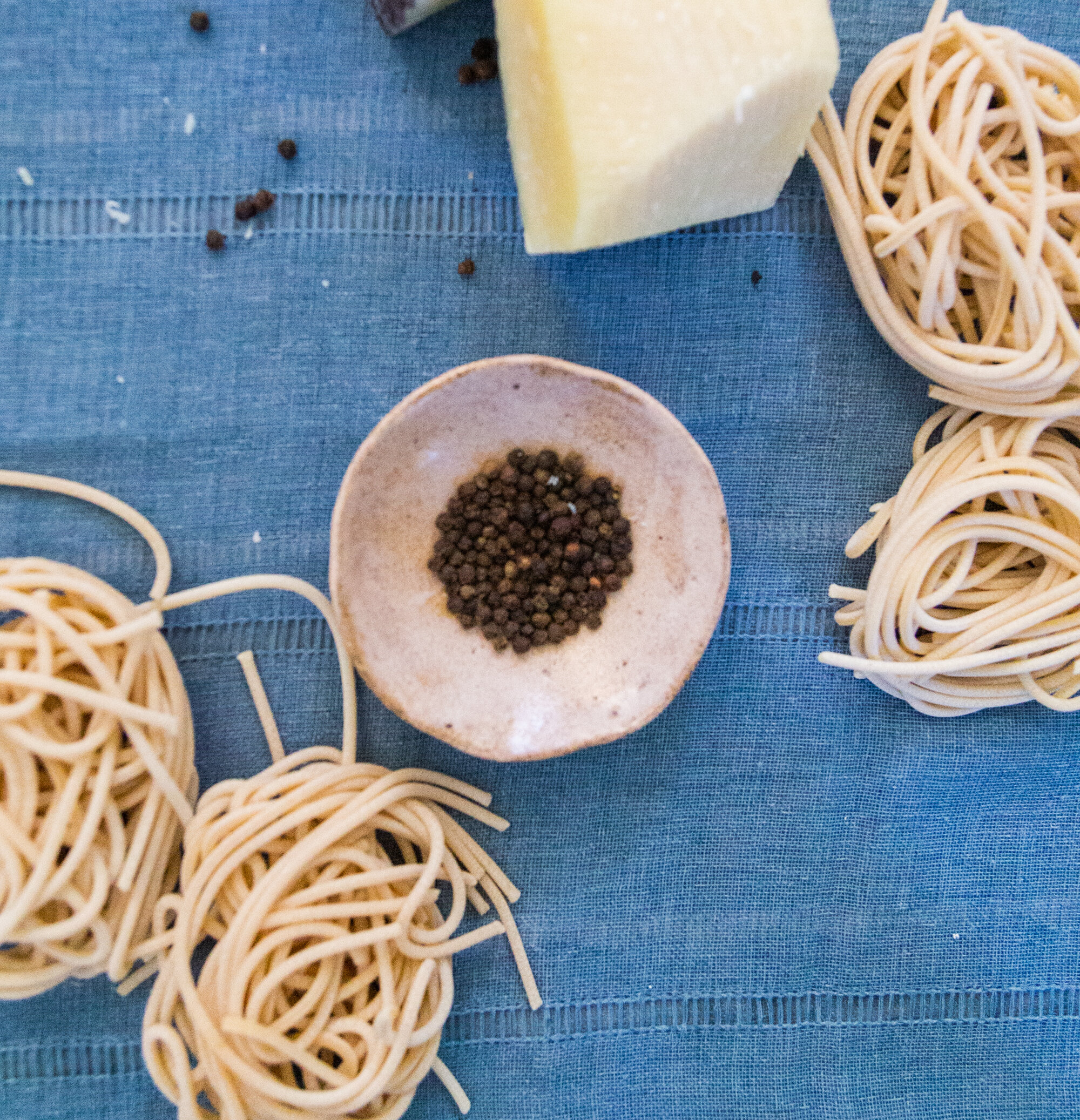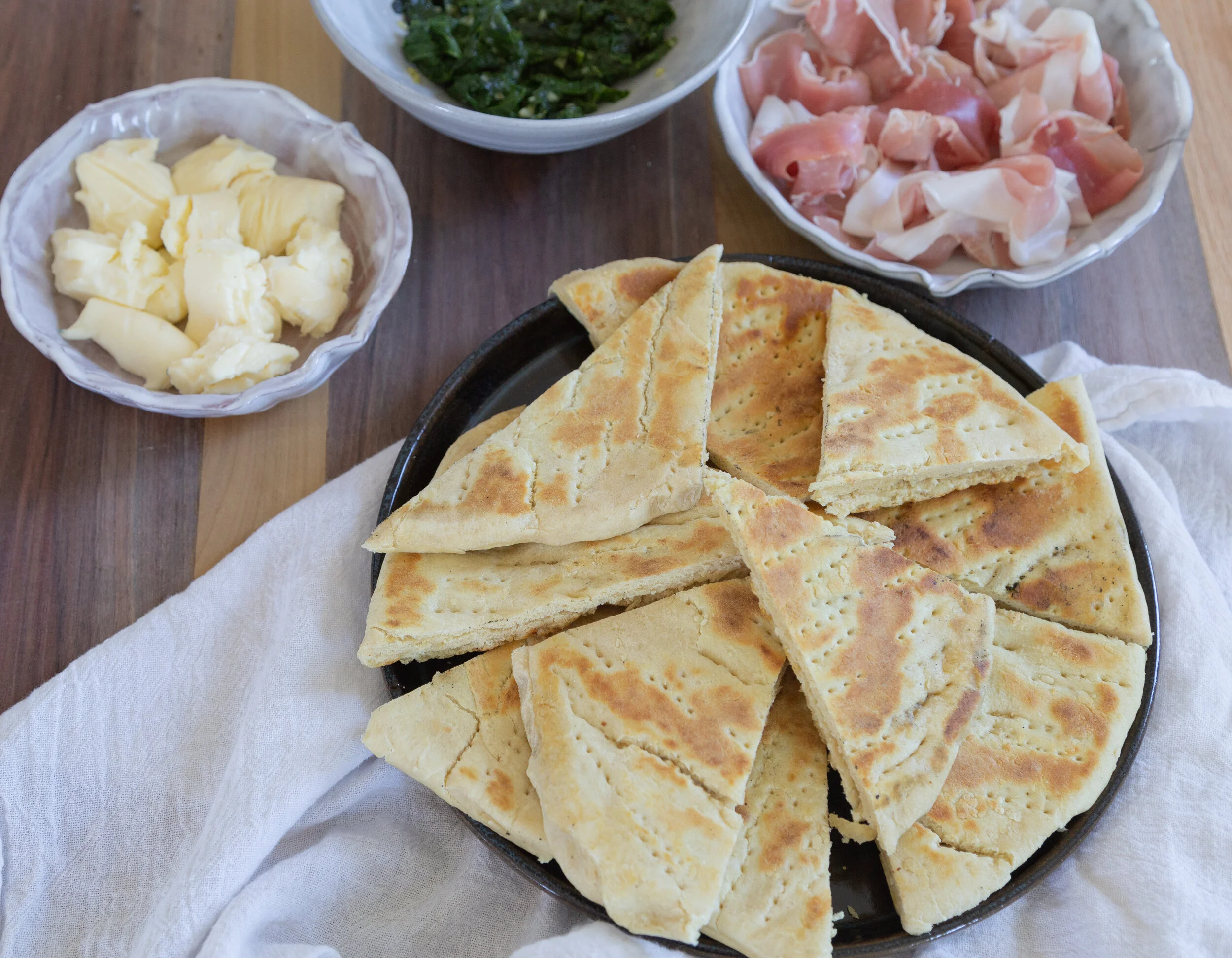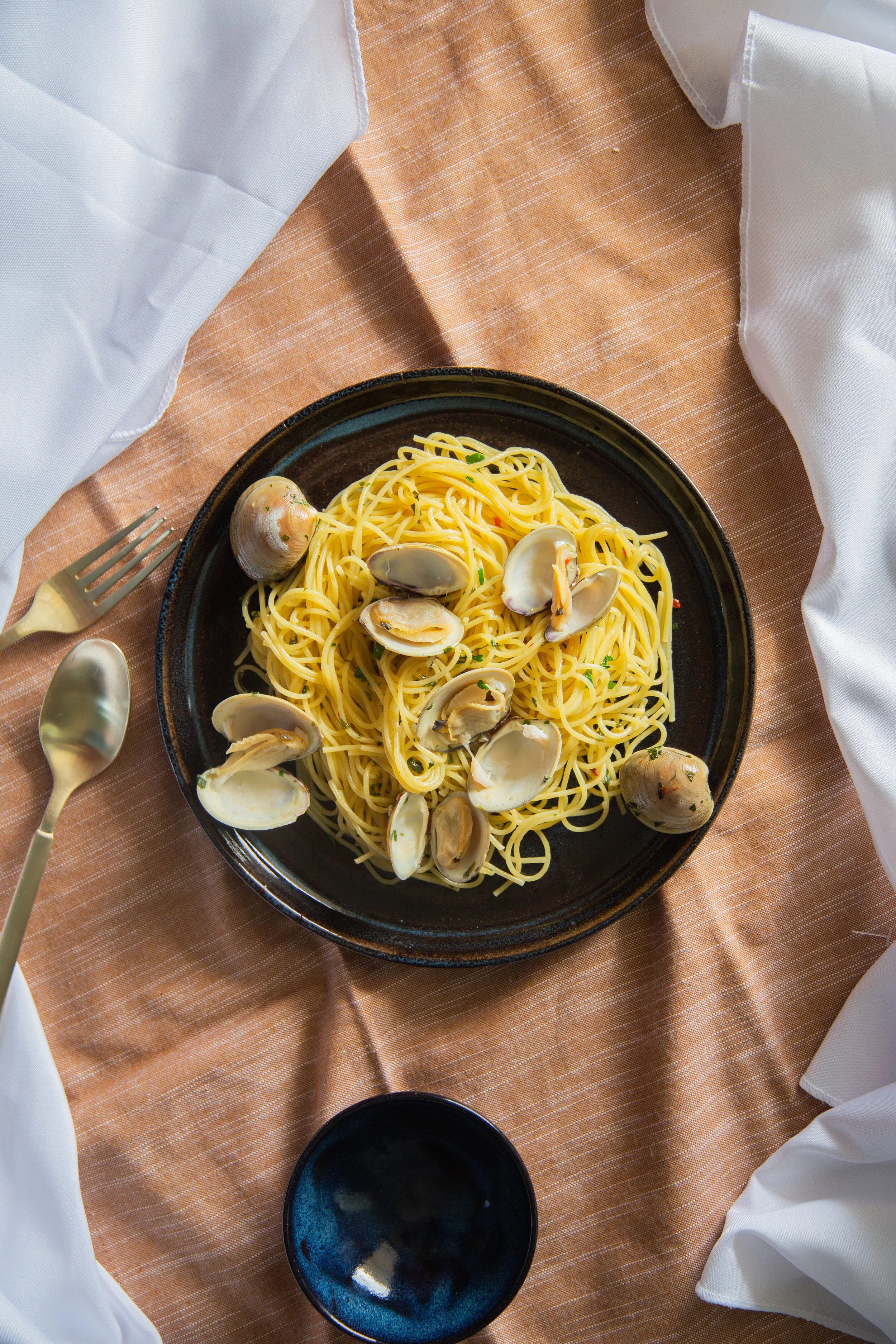Cacio E Pepe & The Perfectly Coated Noodle
Anthony Bourdain once said cacio e pepe “could be the greatest thing in the history of the world.” I wouldn’t dare argue against Bourdain’s claim. No chance. Cacio e pepe truly is one of those most warming and wonderful dishes in the history of the world. Bourdain also refused to disclose his favorite cacio e pepe restaurant in Rome. I’m 99% sure we figured out the mystery eatery but… I wouldn’t dare share it in this post!
I chose cacio e pepe for my first pasta dish for Roaming Italy project because, truth be told, I obsessively sought out the dish during our first trip to Rome. It was the one meal I knew we had to have, straight from the source. Again, thank you Anthony Bourdain for instilling the fervent desire to have peppered cheese pasta on my bucket list.
Before getting into the ultimate recipe for this iconic Roman dish, I want to note one major lesson I’ve learned from the whole experience thus far in my journey in Italian cooking - purity. Let’s get into it…
Perfection in Purity
Italian cooking is not complicated. It is simplicity personified. Take cacio e pepe as an example... three inexpensive, simple ingredients. But what Italian cooking lacks in complex elements, it makes up for in understated purity and a deep understanding of each component.
These three ingredients aren’t just any ingredients - they are the result of hand chosen, perfected processes that result in the best of the best ingredients. Each one of these items are carefully sourced close to home, created in perfect form, cared for, nourished and tended to, then cooked at the absolute prime moment.
That’s why Italian cooking may not be complex in process, but it is intense in purity and essentialism that results in the extraordinary familiar relationship between Italian cooks and their food.
A Perfectly Coated Noodle
Bourdain also stated, "according to Romans, there's good cacio e pepe, adequate cacio e pepe, and everything else, which is of course a sin against God." Let’s just put it out there now… I’m not here to sin against God. At least not today! I’m here to make damn good cacio e pepe.
Three perfect, simple ingredients. Noodles - perfectly coated. Cheese - salty and creamy without any additions of butter or cream. Pepper - potent and aromatic. See what I mean? Purity.
A BRIEF HISTORY
In ancient Roman times, Italian sheep would graze their way up and down the rolling hills of the Apennine Mountains outside of Rome in the warmer months. Shepherds would accompany their transumanza (the Italian word used to describe their twice yearly migration from the highlands to the lowlands) with very little to their disposal.
When it came time to eat, these industrious shepherds combined three easy to carry ingredients - dried tonnarelli pasta, aged pecorino cheese and black pepper - resulting in a portable, delicious meal we now know as cacio e pepe.
TONNARELLI PASTA
In modern creation, cacio e pepe remains just as pure. Lazio-created tonnarelli pasta (similar to a long spaghetti noodle with a chewier bite thanks to the addition of egg) created using a chitarra (“guitar” tool), is crucial. It has the perfect chew and pull, and offers the perfect texture for the coating of fatty cheese and starchy water to nestle in.
When selecting pasta for this recipe, it’s important to seek out pastas with lots of textured goodness on the surface. Opt out of sleek long noodles for this one. Trust me. You want grainy, textured starch dust to give your dish the magical ingredient I’ll get to later!
PECORINO ROMANO
Pecorino Romano… good God above, I love Pecorino! I’ll say it… cacio e pepe without Pecorino is blasphemous.
I’ve read many chefs claim that Pecorino can be mixed with other cheeses for an excellent cacio e pepe. Maybe it’s the traditionalist in me coming out in me… but I just disagree. Keep things simple. We’re a Pecorino only household over here!
It is worth noting that nuttier, sweeter Parmigiano Reggiano was famously added to some modern versions of cacio e pepe thanks to Massimo Bottura’s creation after the 2012 earthquakes in Emilia Romagna! I love Massimo. So if you’re paying homage to his creation and adding Parmigiano to your cacio e pepe… you are forgiven in my book.
Pecorino is in your face, strong, salty, and down right delicious. The beauty of it all is that Pecorino’s boldness is tamed down by the starchy water added to the recipe. Fresh Pecorino from the block (not grated) is my biggest suggestion for your cooking experience because the water concentration makes it a lot easier to melt evenly without an extremely high temperature. Pre-shredded Pecorino (which is actually aged for eight months intentionally for consumption) is fine… but the older the cheese, the higher the temperature must be to melt, which can result in (gasp!) an overcooked noodle.
BLACK PEPPER
The final ingredient - potent whole black peppercorns. Crushed using a mortar and pestle, then toasted and bloomed in the pan. Trust me, these little step makes a big difference! Blooming the peppercorns releases aromatic, flavorful richness to the whole dish. Pepper is not a seasoning in this recipe… it’s a real, integral ingredient in the masterpiece.
The One Mythical Ingredient Unmentioned
Now, there is one magical ingredient I haven’t mentioned yet. It’s the glue that binds together the three floating ingredients. Pasta water. Starchy, glorious pasta water. Magical stuff, right here. This is what makes the cacio e pepe the creamy dish we know it to be.
Let me make one thing clear… never add cream, butter or oil to your cacio e pepe recipe. There is a precious and patient process to creating the smooth emulsion and the perfectly coated noodle.
RISOTARRE
To understand how to get the perfect creamy consistency of cacio e pepe, it’s important to know the process is very similar to that which is used in risottos!
Risotarre is the method Italian cooks use to get that perfectly coated noodle. It requires a lot of care, attention and patience… simply because the rice/noodles are cooked slowly in a small amount pasta water. Cooks add in ladle-full starch water to get the noodles at the right temperature and perfectly al-dente.
For cacio e pepe, a ladle of reserved pasta water is added to a pan of crushed peppercorns first - which allows the aromatic goodness to be spread throughout the dish. As some of the water evaporates, the remaining liquid is filled with high density, starchy goodness. Then, semi-al dente pasta is added to the pan with a few extra ladles of starch water... letting it finish cooking in the pan. Finally, the creamiest concoction of Pecorino and a dash of pasta water is added to the entire mixture. Swift, steady stirring and a healthy toss of the noodles will result in the most creamy, delicious sauce.
Everything in the risotarre method requires patience and perfect timing, otherwise the noodles will be clotted with cheese on the very bottom of the pan. But don’t be overwhelmed… I’ll teach you the ways!
Cacio E Pepe Recipe
Cacio E Pepe
ROAMING ITALY PROJECT
1 pound tonnarelli pasta
2-3 tablespoons salt
2 tablespoons whole black peppercorns, or more to taste
1½ cups Pecorino Romano, freshly grated
Region: Lazio
Begin by boiling a pot of salted water. Add noodles when at a steady boil.
Crush your peppercorns in a mortar and pestle. Take those crushed peppercorns and transfer to a pan on medium high heat.
Toast your crushed peppercorns and let them bloom with fragrance. Be careful not to burn!
Add a ladle of your pasta water to the heated pan with pepper. Allow about a half of the water to evaporate.
Taste your noodles… you’re looking for them to be semi-al dente, but still need cooked. A good tip is to take about 3 minutes off of what the packaging suggests.
Transfer the semi-cooked noodles to your peppercorn/water heated pan using tongs. Do not strain your noodles… simply use your tongs to transfer them over. And make sure to keep your reserved pasta water!
Add about two ladles worth of pasta water to the noodle/peppercorn mixture and stir.
In a separate bowl, add half a ladle’s worth of pasta water to your grated Pecorino. Stir this mixture until it is thick, but not runny.
As your noodles come close to al-dente, take the pan off the heated burner.
Add in your Pecorino cheese mixture. Stir in with care.
Toss your pan so your noodles get a good jump. Keep your noodles moving with the Pecorino mixture. You’ll slowly start to see your mixture coat each noodle and become creamy.
Serve on a plate with an extra dash of pepper and grated Pecorino. ENJOY!
Just For Fun
Okay… how cute is this cacio e pepe enamel pin?
Be sure to watch Anthony Bourdain’s No Reservations Episode on Rome. It really made me fall in love with Rome (and cacio e pepe) before even stepping foot there.
Tonnarelli is the traditional pasta, but I also made it with these Pici noodles and they were the BOMB. They’re a little pricey, but hey…
Alex French Guy Cooking has his own spin on the traditional cacio e pepe recipe. I love the nerdy science stuff he always gets into!
This block print cacio e pepe print would be perfect in any Italophile’s kitchen!
Roscioli, the beloved Roman establishment, has a great Cacio E Pepe Kit!
Cacio e pepe is the ultimate comfort food and an essential part of Italian cooking. I can’t tell you how delicious this stuff is too! (Cue me drooling as I edit these photos…) Gather the best ingredients, savor the process, practice patience when making that illusively delicious creamy sauce… and dang it, enjoy each carb-y bite!
P.S. cook with me! I’d love to see you making each recipe with me! I’m tagging my posts with #roamingitaly on Instagram and TikTok. I’d love to see you use the hashtag in your cooking adventures too!



















